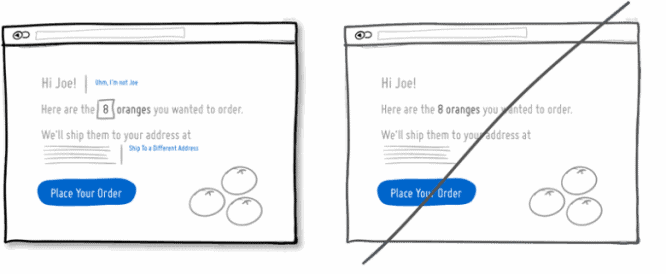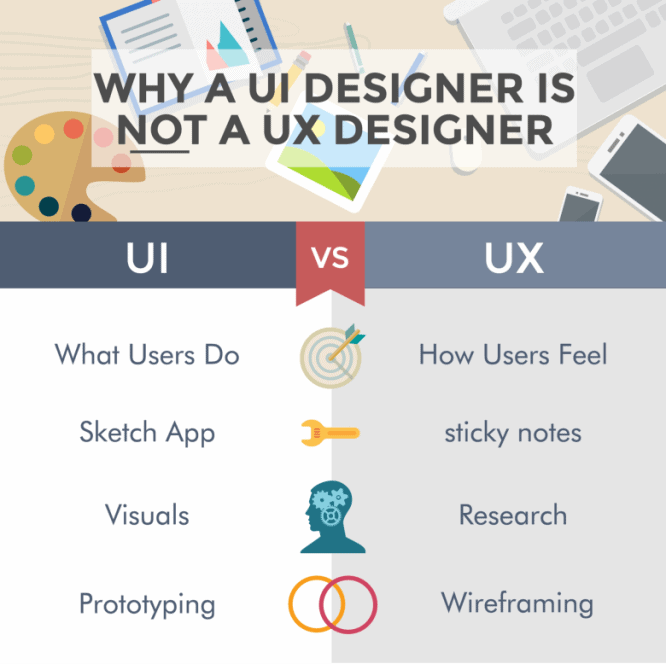What is the difference between UI and UX? Detailed analysis of frequently used terms
In today’s creative and technical environment, the terms UI (user interface) and UX (user experience) are used more than ever. In general, they refer to details and ideas that have been relevant for many years, even before these acronyms appeared.
But the problem with these concepts is becoming more acute. These terms have become buzzwords. Their misuse in completely inappropriate situations often misleads a growing number of design professionals and beyond. Understanding the differences, relationships, and use of these terms is essential in order to work correctly with them.

UI! = UX
The most common misconception that you are likely to encounter in the workplace, meeting with a client, or in a job listing and job listing is the unintentional combination or interchangeability of these terms. In many cases, it is a mistake to expect that the default UI designer understands or focuses on UX just because their work is directly related to users. The fact is, user interface (UI) is not a user experience (UX). Perhaps the confusion arises from the letter “U” in both abbreviations. This is more likely due to the overlap in the skill set required for both disciplines. They are certainly related, and in fact, many designers are knowledgeable and competent in both.
However, despite the overlap, the two areas differ substantially in their nature and, more importantly, in their common goals and objectives. The user interface (UI) is focused on the actual elements of user interaction – mainly physical and technical methods of input and output. UI refers to the collection of approaches and elements that enable the user to interact with the system. It does not touch on details such as how the user responds to the system.

This brings us to UX. But be careful! UX is much more than just the end result of user interaction. On the contrary, it is best viewed as the “core” of the brand. A brand is, in fact, a collection of experience that a person owns in relation to a company or organization. User Experience (UX) is the goal. Not only for the interface, but also for the product, the organization. When you reach a high level of UX, every desired or positive effect imaginable will come from there. UX is focused on overall success. In reality, the product is not the UX, but the experience.
In the end, all that is left for the user is to remember. As we all know, human memory is amazing, but by no means perfect. Literally every detail contributes to the development of the interaction experience, but at the end the user will remember everything somewhat distorted. UX contains many more elements than UI, but it also relies on a lot of detail. Understanding this is the most powerful asset imaginable in product development.
UI is a tool
The user interface is one of the most powerful tools at our disposal for UX. Why? It’s just that the interface is the most tactile and visible method through which users interact with us. UI is the front line. Most likely, this is a more or less acceptable explanation why these two terms are so often confused or used together.
![]()

Misuse is a risk
Communication sometimes misleads us. Developing accurate and specialized terminology tools makes communication easier. What do you think happens if we misuse terms, say one thing and mean another? Not the end of the world, of course, but still the consequences will be … A lot of time, money will be spent, and the result is unlikely to please. Ultimately, all this can lead to bankruptcy, or the exit of the company from the market. Conclusion – incorrect use of terms has disastrous consequences.

Finding the right designer
The most common mistakes in defining UI and UX are where it matters most: job listings and requirements. Every day it becomes more difficult to find a good candidate in such a narrow specialty as UI and UX. It’s worse if you hire someone whose skill set doesn’t match the job. Hiring a good specialist will cost you money, but a candidate who cannot solve the task at hand will cost you much more in the future. Most often, when describing a vacancy, they indicate the responsibilities and requirements of the UI, and the expectations as from a UX designer
Responsibility for the problem
UI or UX is always design. Design is the solution to a problem. When roles are clearly defined and understood by everyone and everyone, it is much easier to attack the problem, propose a solution, and implement it. In the case of UI and UX, the problem usually arises when responsibility for both aspects falls on the shoulders of one person who simply cannot control both.
It is quite difficult to solve a problem that you cannot afford, due to banal incompetence. A UI designer can create interactive designs, icons, color, text, and influence a number of other elements that are directly related to user-system interaction. Elements like these are fantastic tools for influencing the user experience, but they are only part of the equation. UX is influenced by many factors such as marketing, speed, performance, color, personality, customer support, expectations, financial approach, visualization, and more.
It would be rather strange to shift the responsibility for all this onto a UI developer. The same goes for UX. For a developer to rightfully take responsibility for a UX problem, they must be able to recommend and make changes, implement solutions to the problem, and control the process. Understanding the process depends on the capabilities and focus of the designer. It’s not that one designer can’t handle both areas. It’s about tools and the ability to solve problems. In fact, a builder without any materials and tools will not be able to build, like a person without certain skills and knowledge.

Output
The first step to storming any task is to define it. Understanding the differences between UI and UX is your intellectual asset with positive consequences.
From hiring the right designer to simply understanding the requirements and terminology. This is a great way to facilitate communication, design and user experience.
Source: Habr


